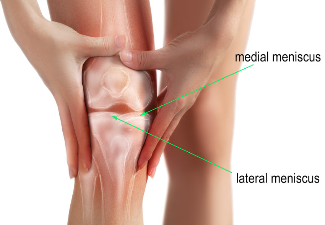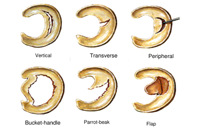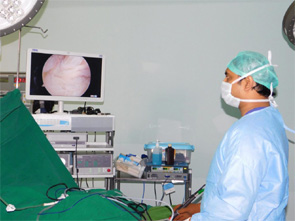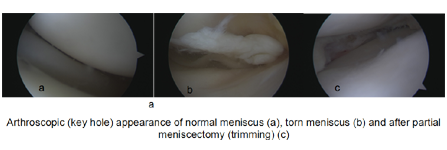Meniscus tears are among the most common knee injuries. Athletes, particularly those who play contact sports, are at risk for meniscus tears. However, anyone at any age can tear a meniscus.

Three bones meet to form your knee joint: your thighbone (femur), shinbone (tibia), and kneecap (patella). There are two pieces of shock-absorbers between the thigh bone and the leg bone. These are called meniscus. They are tough and rubbery to help cushion the joint and keep it stable.
 Menisci tear in different ways, depending on the mechanism of injury. Common types of tears include bucket handle, flap, and radial, complex.
Menisci tear in different ways, depending on the mechanism of injury. Common types of tears include bucket handle, flap, and radial, complex.
Sports-related meniscus tears can often occur along with other knee injuries, such as anterior cruciate ligament tears. To read more about ACL injuries…
Cause
Meniscal tears in the young usually occur after a significant injury during sports (twisting injury to the knee) caused by a tackle or an improper jump and land. It can also occur after a motor vehicle accident. Older people are more likely to have degenerative meniscus tears. Cartilage weakens and wears thin over time. These menisci are more prone to tears. It can occur just after an awkward twist or when getting up from a chair or getting out of a car or sometimes even when you are climbing stairs.
You might feel a noise like a “pop” when you tear a meniscus. many times you can still walk on the injured knee. Athletes can sometimes keep playing with a tear. Over 2 to 3 days, your knee will gradually become more stiff and swollen.
The most common symptoms of meniscus tear are:
- Pain
- Stiffness and swelling
- Catching or locking of your knee
- The sensation of your knee “giving way”
- Sensation of something moving in the joint
- Sometimes you will not be able to straighten your knee. This is because a piece of torn meniscus may be caught between the bones, obstructing the movement. This is called a locked knee. If you experience a locked knee, please see your knee surgeon immediately and do not forcefully straighten the knee or walk on it as you may end up damaging the meniscus further.
After a detailed history, your knee surgeon will perform certain tests to ascertain the presence of a tear. He may request you to undergo certain radiological tests.
Imaging tests
 X-rays: Although x-rays do not show the status of the meniscus, they are important to rule out other causes of knee pain like osteoarthritis. In case of an injury, it helps to rule out a fracture.
X-rays: Although x-rays do not show the status of the meniscus, they are important to rule out other causes of knee pain like osteoarthritis. In case of an injury, it helps to rule out a fracture.
Magnetic resonance imaging (MRI): This study can assess the joint in detail and also give information about the type and degree of tear and throw light on if a tear can be repaired.
Treatment of meniscal tears may depend on the type, location and degree of tear, your age, activity level and duration since injury and any other associated injury like an ACL tear. The outside one-third of the meniscus has a rich blood supply. A tear in this “red” zone may heal on its own, or can often be repaired with surgery. In contrast, the inner two-thirds of the meniscus lacks a blood supply. The tears in this zone usually do not heal and may need to be trimmed surgically.
Nonsurgical treatment
Not all meniscus tears need surgery. There are many tears which can be managed without surgery.; please discuss the best treatment for you with your knee surgeon.
An outline of non surgical treatment is as follows.
Rest: Take a break from the activity/ sport that caused the injury. Your doctor may recommend crutches to avoid putting weight on your leg.
Ice: icing the knee regularly helps reduce pain and swelling. Do not apply ice directly to the skin.
Compression: To prevent additional swelling your surgeon may recommend an elastic compression bandage. Your surgeon may recommend some pain medications to help the pain temporarily.
Surgical Treatment
If your symptoms persist even after nonsurgical treatment, your doctor may suggest arthroscopic surgery. However, certain types of tear may need surgery as a first line of treatment and your surgeon may recommend the same as soon as it is diagnosed.
Procedure

Knee arthroscopy is one of the most commonly performed surgical procedures. In it, a miniature camera (arthroscope) is inserted through a small puncture hole (portal). The camera allows for detailed examination of the knee. Your orthopaedic surgeon inserts miniature surgical instruments through other portals to confirm the type and location of the tear. Once he has done so he will either trim or repair the tear.
Partial meniscectomy: In this procedure, the damaged meniscus tissue is trimmed away. This procedure will make sure there are no loose/ unstable parts of meniscus within the joint and hence reducing pain.

Meniscus repair: Some meniscus tears can be repaired by suturing (stitching) the torn pieces together. Whether a tear can be successfully treated with repair depends upon the type of tear, as well as the overall condition of the injured meniscus.

Once the initial healing is complete, your doctor will prescribe rehabilitation exercises. Regular exercise to restore your knee mobility and strength is necessary. You will start with exercises to improve your range of motion. Strengthening exercises will gradually be added to your rehabilitation plan.
Rehab time for a meniscus repair is about 3 months. A meniscectomy requires less time for healing — approximately 2 to 3 weeks.
Recovery
Meniscus tears are extremely common knee injuries. With proper diagnosis, treatment, and rehabilitation, patients often return to their pre-injury activity level/ sport.

